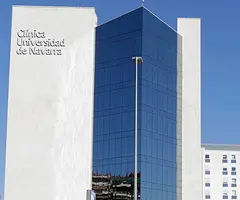Pancreatic cancer
"Of the factors known to favor the appearance of pancreatic cancer, tobacco is the one that seems to have demonstrated its association in more studies".
DR. MARIANO PONZ
SPECIALIST. LIVER AND PANCREATIC CANCER AREA

What is pancreatic cancer?
Pancreatic cancer is a type of tumour that arises when cells in the pancreas proliferate in an uncontrolled manner, disrupting the normal mechanisms of cell growth regulation. The pancreas is an organ located behind the stomach and colon, in contact with critical abdominal structures such as the duodenum, the bile duct, intestinal arteries and veins, the aorta, etc.
Pancreatic cancer is rarely detected in early stages, due to the absence of specific symptoms in the early stages. Symptoms usually manifest themselves in advanced stages. It is one of the most aggressive tumours of the digestive tract. The proximity of the pancreas to vital structures contributes to its biological aggressiveness and the difficulty in establishing an early diagnosis.
Most patients present with locally advanced or metastatic disease at diagnosis, limiting curative treatment options. Although advances in imaging techniques, molecular diagnostics and multimodality approaches have improved disease management, the overall prognosis remains poor.

A PERSONALIZED MEDICINE
Second Opinion,
peace of mind
Request a second opinion from our professionals with great experience in the diagnosis and treatment of oncological diseases
In 3 days, without leaving home.
Symptoms of pancreatic cancer, the most common signs
Weight loss
Unintentional weight loss is a common initial symptom, usually related to the systemic metabolic impact of the tumour, malabsorption secondary to exocrine pancreatic insufficiency, or anorexia associated with tumour progression.
Jaundice
Jaundice is a prevalent symptom in tumours located in the pancreatic head. In these cases, early infiltration of the common bile duct causes obstruction of bile flow from the liver to the intestine. This interruption causes the patient to become "yellow" and often has generalised itching, due to the lack of elimination of bile salts.
Back pain
Back pain, theoretically at the level of the stomach, is another common symptom, especially in tumours affecting the body of the pancreas, and is a sign of nerve plexus infiltration and therefore poor prognosis.
Generalised itching
Although this symptom is mentioned together with jaundice, generalised itching or pruritus may be a prominent and isolated symptom in some cases, preceding the visible jaundice. This symptom is a consequence of the accumulation of bile acids in the systemic circulation.
Do you have any of these symptoms?
If you suspect that you have any of the above symptoms,
you should consult a medical specialist for a diagnosis.
Risk factors for pancreatic cancer
- Age: the risk increases sharply after the age of 50. At the time of diagnosis, most patients are between 60 and 80 years of age.
- Race: black people are more likely to be diagnosed than other ethnic groups.
- Smoking: the risk is higher in smokers.
- Family history: the exact genes responsible have not been properly identified, although DNA alterations that increase a person's risk of other cancers increase the risk of pancreatic cancer.
- Obesity: people with a body mass index (BMI) over 30 are more likely to develop pancreatic cancer.
- Chronic pancreatitis: this long-term inflammation of the pancreas is associated with a slightly increased risk of pancreatic cancer.
- Sudden-onset diabetes: diabetes can be a risk factor and an early symptom of pancreatic cancer.
- Edad: el riesgo aumenta de manera pronunciada después de los 50 años de edad. En el momento del diagnóstico, la mayoría de los pacientes tienen entre 60 y 80 años de edad.
- Raza: las personas de raza negra tienen una mayor probabilidad que otros grupos étnicos.
- Tabaquismo: el riesgo es mayor en los fumadores.
- Antecedentes familiares: los genes responsables exactos no han sido debidamente identificados, aunque las alteraciones del ADN que aumentan el riesgo de una persona de padecer otros tipos de cáncer incrementan el riesgo de cáncer de páncreas.
- Obesidad: las personas con un índice de masa corporal (IMC) superior a 30 tienen más probabilidades.
- Pancreatitis crónica: esta inflamación prolongada del páncreas se asocia a un riesgo ligeramente mayor de cáncer de páncreas.
- Diabetes de inicio repentino: la diabetes puede ser un factor de riesgo y un síntoma precoz de un cáncer de páncreas.
What are the causes of pancreatic cancer?
Of the factors known to favour the development of pancreatic cancer, smoking is the one that has been shown to be most clearly associated in numerous studies.
Other factors, such as alcohol, coffee and fat consumption, are not clearly associated with pancreatic cancer.
A diet rich in vegetables and fruit has been shown to be beneficial in the prevention of this cancer, as with others.
How is pancreatic cancer diagnosed?
Diagnosis in the early stages of the disease is sometimes difficult. When jaundice appears, in addition to blood tests, the most appropriate initial examination for diagnosis is ultrasound.
In most cases, an abdominal CT scan will be necessary to make a correct diagnosis and to assess the extent of the disease.
Especially if surgery is not possible, a sample should be taken to confirm the diagnosis. This biopsy can be performed by digestive endoscopy or, if necessary, echoendoscopy, or by fine-needle aspiration (FNA), which is directed to the desired area with radiological control.
Treatment for pancreatic cancer
The only curative treatment for pancreatic cancer is surgery, which involves the removal of the pancreatic head along with the bile duct, duodenum and sometimes part of the stomach. It is a relatively long surgery with a sometimes complicated postoperative period.
Nowadays, the mortality rate of the operation is practically zero. In recent years, chemotherapy and radiotherapy treatments have been developed to complement surgery, both before and after the operation. Palliative treatment focuses on reducing symptoms to improve quality of life: relieving pain and resolving biliary and, where appropriate, digestive obstruction.
Pain is usually controlled in Pain Units and, on occasion, it may be necessary to resort to procedures to "destroy" the affected nerves. Palliation of jaundice can be achieved by placing a prosthesis in the obstructed bile duct.
What clinical trials do we have on Pancreatic cancer?
Where do we treat it?
IN NAVARRA AND MADRID
The Liver and Pancreatic Cancer Area
of the Cancer Center Clínica Universidad de Navarra
The Liver and Pancreas Cancer Area is a multidisciplinary area exclusively for the comprehensive approach of tumor pathology of the liver, pancreas and biliary tract, as well as living donor liver transplantation.
Patient care will be coordinated by a single reference person who is an expert in these pathologies and who will be in charge of informing and coordinating consultations, tests, treatments, surgeries, etc., in less than 24 hours.
Diseases we treat
- Pancreatic Cancer
- Bile duct cancer (Cholangiocarcinoma)
- Hepatocarcinoma or Liver Cancer
- Liver Metastases
- Other Liver Tumors

Why at the Clinica?
- Integral evaluation of the patient.
- Possibility of beginning personalized treatment 24 hours after the first consultation.
- Minimally invasive surgery for the best recovery of patients.




















































